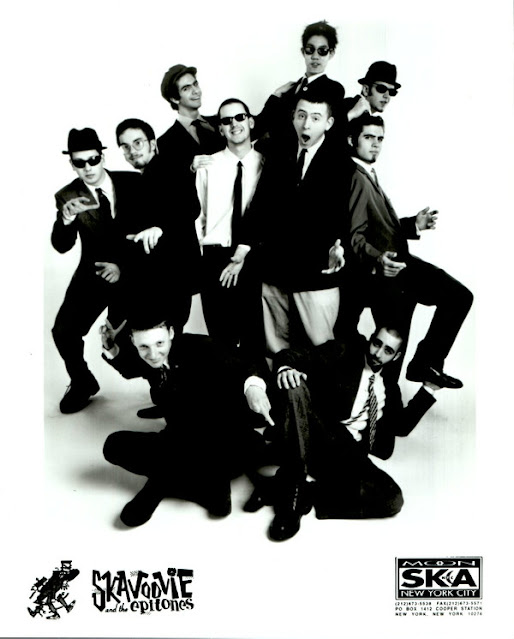If you need a refresher on this album, you can read my appreciation of Celebrate the Bullet from this 2010 post.
Also, below is a chapter relating to Celebrate the Bullet excerpted from my 2020 book The Duff Guide to 2 Tone:
"The Lost Interview: Neol Davies of The Selecter"
Back in 2015, I was planning to expand a post I had written several years earlier reappraising The Selecter's Celebrate the Bullet [which is included in The Duff Guide to 2 Tone] to book-length. Hoi Polloi skazine's John Vaccaro had been incredibly kind to send me several contemporary articles related to the album from Sounds, NME, and other British music publications from his extensive print archives for my research. I also managed to arrange a series of interviews with Selecter founder, guitarist, and primary songwriter Neol Davies, and intended to talk with other members of the band who had composed songs for the Celebrate the Bullet, including Pauline Black, Gaps Hendrickson, and Compton Amanor.
That summer, I spoke twice with Davies via Skype, but during each session, our video calls were plagued by technical issues: the audio would often go in and out and inevitably degrade to static. Davies was generous and gracious during our interviews—and quite eager to talk about an album that he clearly felt never received its due—but was increasingly frustrated and distracted by the audio problems. I digitally recorded both interviews, but much to my regret didn't have them transcribed at the time. I had planned to set up additional phone calls with Davies, but, unfortunately, didn't, due to demands of work and life.
While putting together The Duff Guide to 2 Tone, it struck me that excerpts from my interviews with Neol Davies would be perfect for this book, but I have been unable to locate the audio files, which I thought I had copied to an external hard drive. Unfortunately, the device I used to record the interviews died several years ago and was recycled. However, I do have the notes that I typed up after my conversation with Davies on 8/13/15, which are as follows.
The cover of Celebrate the Bullet, which was designed by Davies' late wife Jane Hughes and John "Teflon" Sims of Chrysalis' art department (who, along with David Storey, created much of 2 Tone's iconic imagery), featured a gloved hand of a person who couldn't be identified as a man or woman, or black or white—they represented everyone. The fuzzy TV screen on the UK version of the album was meant to convey that the music and message was not being broadcast or given airtime in the mainstream media, and also expressed a dread of nuclear annihilation (when all transmissions will cease). Davies commented that the band was "angry with the world."
Hughes also designed the new Selecter "dial" or "eyeball" logo (used on the paper label for the album and "Celebrate the Bullet" single). It was greatly influenced by Soviet constructivist artists and "fits nicely as a paper sleeve for a single or album—and allows for text, too." Davies noted that it was simple, but "not so easy to arrive at."
Davies stated that, in contrast to The Specials, which was "very much a dictatorship with Jerry in charge," The Selecter was a real democracy. Each member had an equal vote and they based all of their decisions on whichever options had the most support. The band voted down Davies on who should produce their debut album Too Much Pressure. Davies had wanted Roger Lomas, who had produced The Selecter's first few singles, including "The Selecter" and "On My Radio" b/w "Too Much Pressure." In the end, the band opted to go with Charley Anderson's friend Errol Ross, but Davies and others were very unhappy with the results. As a consequence, Lomas was recruited to produce "The Whisper" single and the Celebrate the Bullet album. (A few years prior to this interview, Davies thought he had tracked down the two-inch reel-to-reel tapes for Too Much Pressure with the idea of remixing the whole album for a re-release, but the boxes were empty.)
According to Davies, the track "Celebrate the Bullet" is "a direct descendent" of "The Selecter" instrumental. The song is about recognizing "the seduction of the power of holding a gun in your hand and being enthralled by the power of a gun—but also being very anti-gun." When I asked him about Chrysalis' reaction to the controversy surrounding the single [the BBC had quietly banned the track over misguided concerns that it encouraged gun violence; John Lennon had been murdered a few months earlier and an assassination attempt had been made on President Ronald Reagan around the time of the single's release], Davies noted that the label gave their "full support" to The Selecter.
Davies felt that the "Celebrate the Bullet" single "should have been our 'Ghost Town'"—The Selecter's #1 record. Like that Specials masterpiece, The Selecter's "art and music was in synch with real world events and the zeitgeist" of those turbulent times. Davies said that he found it "mystifying that an anti-gun and anti-violence record would be banned during a time when people were being assassinated."
+ + + +












